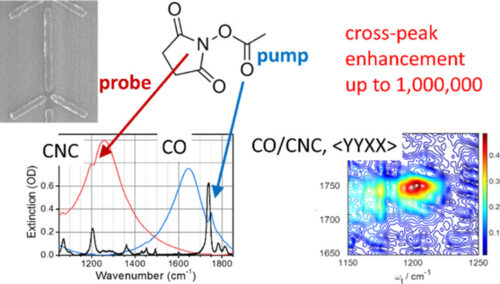Extension of surface-enhanced two-dimensional infrared spectroscopy (SE-2DIR) to dual-frequency experiments allows studying dynamics and energy transport in thin molecular films by tagging and probing vibrational modes on different sites of the molecule. Measurements of cross-peaks involving transitions largely separated in frequency by SE-2DIR require plasmonic nanostructures with resonant excitations at the corresponding frequencies, where the associated enhanced near-fields spatially overlap and different molecular transitions are simultaneously enhanced in the same molecule. Gold trimer infrared antennas localize enhanced fields within the gap formed by their arms. We exploit the symmetry of trimer antennas to individually tune frequencies of the in-plane plasmonic excitations to match molecular transitions of interest. Dual-frequency SE-2DIR measurements are demonstrated on 4-azidobutyrate-N-hydroxysuccinimide ester with the cross-peaks between the carbonyl and azido stretching vibrational modes, separated by 370 cm–1, and the carbonyl and C–N–C stretching modes, separated by 550 cm–1. Excitation with cross-polarized laser pulses allows appropriate plasmon excitations in resonance with the relevant molecular transitions to be selectively accessed. Our approach, based on the rational plasmon mode engineering, achieves significant enhancement of the cross-peak signals involving largely separated transition frequencies, which is not possible with single broadband plasmon modes.
Authors: Robert T. Mackin, Bar Cohn, Ben Engelman, Adi Goldner, Igor V. Rubtsov and Lev Chuntonov
Publication date: 2019/9/12
Journal: The Journal of Physical Chemistry
Volume: 123
Issue: 40
Pages: 24731-24739



